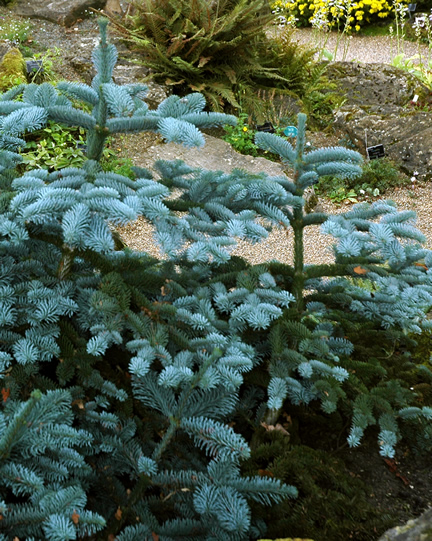| General Description | Noble firs are the largest trees in the Abies genus. The tree has a pyramidal form and a bluish green colour. The bark breaks up into plates as it ages giving the trunk a rough look. It has large purple cones that change to brown as they mature. |
| ID Characteristic | Noble fir needles are bluish green with notched tips, and there are two white lines of stomata on the underside of them, buds have long pointed scales at the base and are resinous. The noble fir also has large, purple cones. |
| Shape | The noble fir has a conical shape when young; as it matures it gains a symmetrical pyramidal shape. |
| Landscape | Noble fir is used as a specimen tree or vertical accent because of its appealing pyramidal form and dark green foliage. It is also used as a Christmas tree because it has the longest lasting needles of the firs, a nice form and soft green foliage. One consideration to keep in mind is that Noble fir can reach up to 30 m tall so it requires a large amount of space. |
| Propagation | Noble fir can only be propagated via seed and stratification is required. Typically moist filter paper stratification has a higher germination success rate than naked stratification. In the moist filter paper method dry seeds are put on a moist medium and then they are refrigerated. In the naked stratification method seeds are hydrated before they are placed in plastic bags and then refrigerated. Seeds should be stratified for 3 months. Propagation is difficult for this species because seed production and quality is quite low (10% viable seeds per tree). |
| Cultivation | Stratified seed should be planted in February or March. Germination can take several weeks and chances of success are greater if seeds are sown in shady, cool, and moist conditions. Transplanting works well for seedlings and small saplings. Noble fir performs best in well drained, acidic soils and full sun. It is not tolerant of windy conditions and alkaline soils. |
| Pests | The noble fir is susceptible to a number of pests and diseases including conifer root aphids, interior needle blight, grovesiella canker, root rot, and noble fir bark beetle. |
| Notable Specimens | Whistling Gardens in Wilsonville, Ontario Canada has noble fir specimens as well as several cultivars. There are also fir stands at the University of British Columbia forestry research lands in Vancouver, British Columbia, Canada. |
| Habitat | Under natural conditions noble fir grows in subalpine forests with moraine soil and rough terrain. It grows best in areas with an herbaceous understory and it can tolerate a wide range of soil types as long as there is adequate moisture. |
| Bark/Stem Description | The bark of young trees is smooth and grey and contains resin blisters. As the tree matures the bark turns reddish brown and plates form, which gives the trunk a furrowed look. Younger branches are pubescent. |
| Flower/Leaf Bud Description | Buds are roundish, resinous, and have a collar of pointed scales at its base. |
| Leaf Description | Needles are 25 – 38 mm long and about 20 mm wide. They are a bluish green colour with 2 white stomatal bands on the underside. Needles curve upwards and there are two rows of needles per branchlet. |
| Flower Description | Flowers are monoecious and fairly nondescript. Male strobili are on the underside of branches and found in groups of up to 30. Pollen is a pink colour and will make the male flower appear reddish. Female strobili are erect with long pointed bracts and they are located near the top of the tree on the upper-side of branches; they occur singly or in groups of two. |
| Fruit Description | Cones are 18 – 23 cm long and 7 cm wide. They are a purplish brown colour and stand erect on the branches. Each cone scale has a bract which makes the cone look like it is covered in shingles. |
| Colour Description | Needles are a bluish green colour; the bark starts out grey and turns reddish brown; cones are purplish brown. |
| Texture Description | Medium. |
